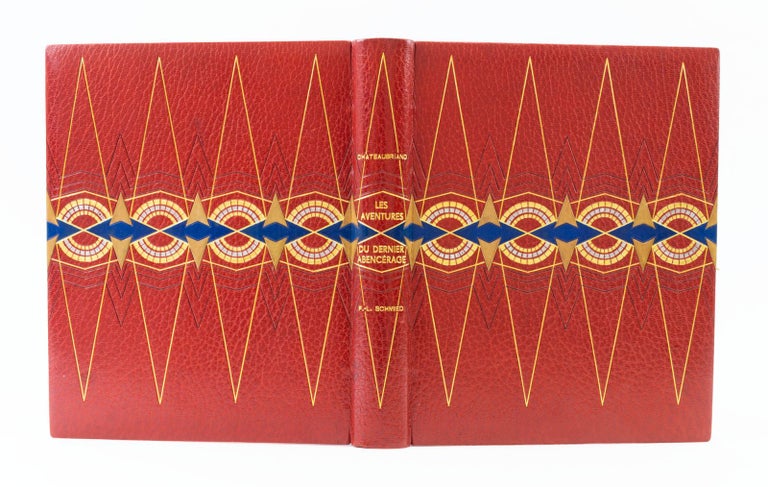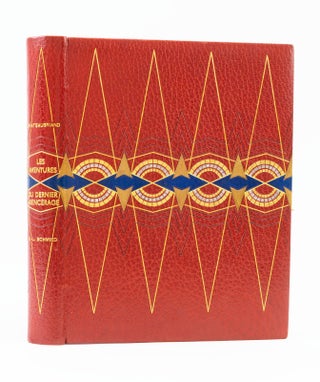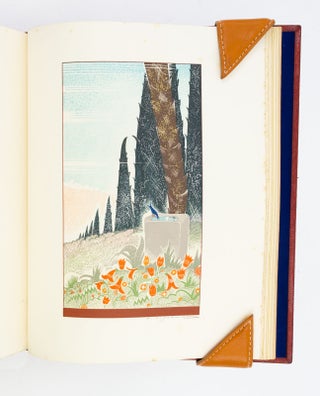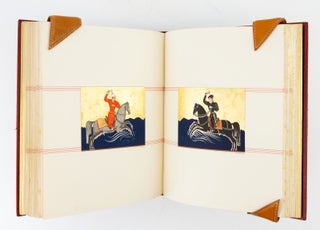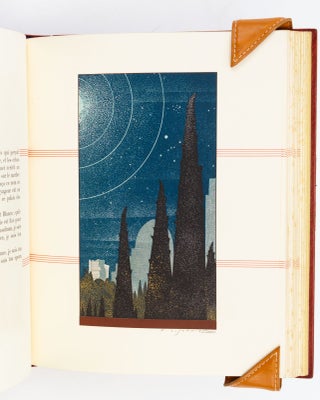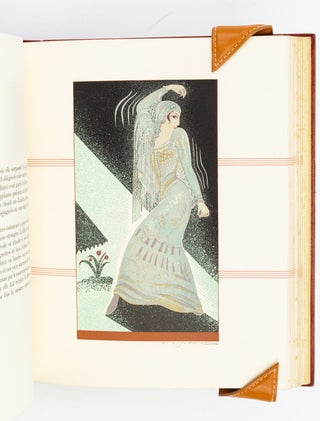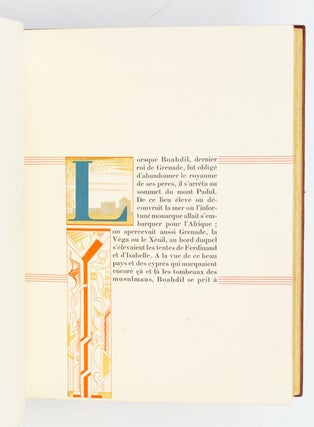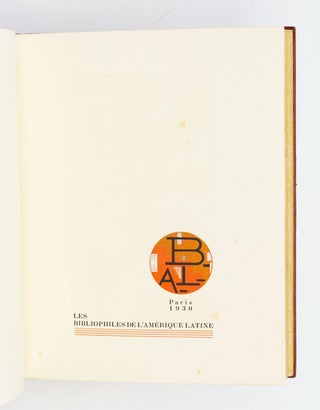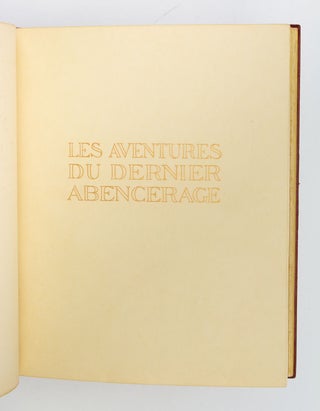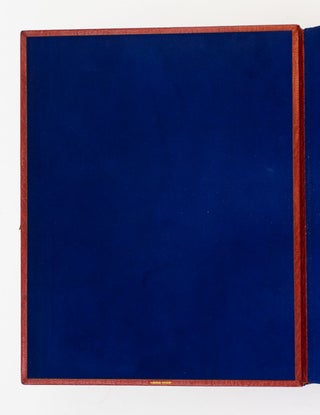LES AVENTURES DU DERNIER ABENCERAGE.
(Paris: Les Bibliophiles de l'Amérique Latine, 1930). 253 x 199 mm. (10 x 7 3/4"). [73] leaves.Designed by Theodore Schmied. No. 60 OF 100 COPIES printed for members of the Society and SIGNED by Schmied, from a total edition of 140; this copy printed for Madame la Princesse de Faucigny-Lucinge [Baba d'Erlanger].
DRAMATIC SIENNA CRUSHED MOROCCO, GILT AND INLAID TO AN ART DECO DESIGN BY THERESE MONCEY (stamp-signed by Moncey on front turn in and by Fache, Doreur, on rear turn-in), covers and smooth spine with wrap-around design of inlaid morocco stars formed by blue lozenges and citron triangles alternating in a row with circles of silver and gold, the silhouette of this band outlined by one gilt and three blind rules, gilt-rule triangles emanating from either side of each circle and reaching toward head and tail edges, gilt lettering to spine, navy blue suede doublures and free endleaves, all edges gilt. Original wrappers bound in. Original matching morocco-trimmed chemise and slipcase, housed in a wood-grained clamshell box trimmed with purple morocco (mellowed to mauve on back), tan calf title label on back. With Art Deco head- and tailpieces and initials, 22 WOOD ENGRAVED PLATES, COLORED IN POCHOIR AND HIGHLIGHTED IN GOLD, all by Schmied. Ritchie 39. ◆A sprinkling of faint spots of foxing to opening and closing leaves, light offsetting from illustrations, but A FINE, FRESH COPY, clean and bright internally with vibrant colors, IN A SPARKLING, UNWORN BINDING.
Beautifully illustrated by an outstanding book artist, Chateaubriand's tale of Moorish Spain is offered here in a binding designed by an award-winning artisan and executed by the leading doreur of the time. Our stylish volume has an equally stylish provenance, as it was printed for society beauty Baba d'Erlanger, whose exotic looks and dramatic personal flair influenced contemporary fashion and culture--including, perhaps, the illustrations here.
An innovative binding designer active from the 1940s until 1965, Thérèse Moncey won the grand prize for French bookbinding in 1950 and participated successfully in numerous expositions. Her designs typically combine sinuous inlays and gilt tooling, and incorporate elements from the volumes they cover—often lavishly illustrated bibliophile editions like the present work. Our binding stands out from her other designs because of its straight lines and angular geometric shapes, which were clearly inspired by Schmied's Art Deco illustrations. The colors of the morocco are those chosen by Schmied for the book's decorations. Moncey worked with the greatest finishers of the period to execute her bindings, foremost among them the artisan responsible for this work, Jules Fache (1901-72). Trained as a gilder under Adolphe Cuzin, son of the great Francisque Cuzin, Fache established himself as an independent gilder and decorator of bindings in 1924. Flety—who devotes more column inches to Fache than to many well-known binders—tells us he was "a highly talented gilder craftsman, with a spirit always oriented towards the search for perfection and the growth of his knowledge," who worked for "most of the great bookbinders and designers of his time." He was the author of two works that Flety considers a complete guide to the knowledge and techniques of the gilder and book decorator.
Immensely talented in all areas of book production, François-Louis Schmied (1873-1941) was one of the most important, original, and active figures in the world of artist's books. For many of his productions, he took on the responsibility for creating the illustrations, designing the typeface and page layout, setting the type, and doing the printing. Schmied was born and studied in Geneva, moved to Paris at 22 to make a living as a wood engraver, and joined the French Foreign Legion in his mid-forties, losing an eye in the Great War. It was after 1919 that Schmied began to focus primarily on the production of "éditions de luxe," often entirely the work of his own hands, and in the mid-1920s, he and his eldest son, Théo, managed an atelier that issued a distinguished series of sumptuous works in very small editions, largely for members of elite French book clubs.
The member of Les Bibliophiles de l'Amérique Latine for whom this volume was printed was French style icon Baba d'Erlanger (Baroness Mary Liliane Matilda d'Erlanger, later Princess Jean-Louis de Faucigny-Lucinge, 1901-45). She was a model and muse to photographer Cecil Beaton, who said, "Baba d’Erlanger-Lucinge was the first to bring into fashion the exotic, simian grace of the jungle and thereby created an astonishing effect of originality." No mere fashionista, Baba was also a patron of the arts, championing Picasso and Dali, among others. Perhaps by coincidence, or perhaps because of her prominence as a trendsetter in Parisian style, Schmied's depictions of Chateaubriand's heroine, Blanca, bear a striking resemblance to Baba, with her large, almond-shaped eyes, dramatic brows, strong features, and black hair. A major influence on writers from Byron to Victor Hugo, Chateaubriand (1768-1848) wrote this account of two rival families—one Christian and one Muslim—in 15th century Granada, culminating in the massacre of the Abencerages family in a court of the Alhambra palace. (ST17562)
Price: $18,000.00

